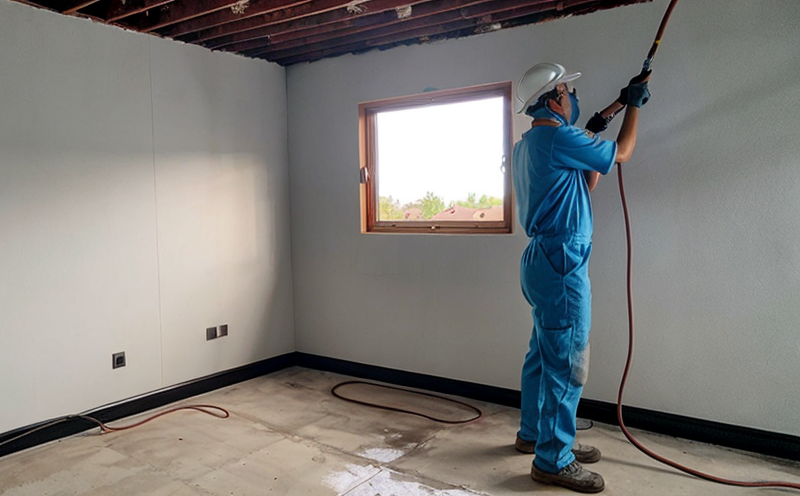Fireproofing coating inspection
Finding ourselves in a world where fire hazards are inevitable, ensuring that structures and materials can withstand such events is paramount. Fireproofing coatings play an instrumental role in safeguarding buildings against fire damage by providing a protective layer that delays the transfer of heat through steel structural members. This service focuses on inspecting these critical fireproofing coatings to ensure they meet specified standards and provide adequate protection.
Our comprehensive inspection process includes detailed visual assessments, thickness measurements, adhesion tests, and thermal conductivity evaluations. These steps are vital in verifying that the coating meets the required specifications for both performance and safety. The importance of fireproofing cannot be overstated; it is a critical component in minimizing structural damage during fires, thereby protecting lives and property.
The inspection process begins with thorough visual examinations to identify any obvious defects or inconsistencies in the application. Following this, we measure the thickness of the coating using specialized equipment to ensure that it meets the prescribed minimum requirements outlined by relevant standards such as ASTM E1960 or ISO 26178-3:2015.
Adhesion tests are conducted to check the bond strength between the fireproofing material and the substrate. This is crucial because poor adhesion can lead to premature failure of the coating during a fire, rendering it ineffective. Adhesion testing methods may include pull-off tests or shear tests according to ASTM C782 or EN 1369.
Thermal conductivity measurements are essential for assessing how well the coating performs its insulating function by minimizing heat transfer through steel members. Lower thermal conductivity values indicate better insulation properties, which is critical in fireproofing applications. According to ISO 25722:2013, these tests help determine if the coating adheres to specified levels of thermal resistance.
Once all inspections are completed, we generate detailed reports that provide a comprehensive overview of each inspection point's findings. These reports include photographs, measurement data, and test results, ensuring transparency and traceability throughout the entire process. Our goal is not only to meet regulatory requirements but also to exceed expectations by delivering reliable, high-quality inspection services.
Quality managers and compliance officers can rely on our expertise to ensure that their structures are up-to-standard with fireproofing coatings. By partnering with us, they gain access to the latest testing methodologies and industry best practices, helping them maintain a safe environment while complying with international standards like ISO 26178-3:2015.
R&D engineers will find our services invaluable for validating new formulations or materials used in fireproofing coatings. Our rigorous inspection processes provide valuable feedback that can inform continuous improvement efforts, ensuring that innovations are both effective and compliant with relevant regulations.
Benefits
- Enhanced Safety: Ensures compliance with fire safety codes and standards, reducing the risk of structural collapse during fires.
- Increased Durability: Properly applied coatings can extend the life span of steel structures by protecting them from excessive heat exposure.
- Saved Costs: Preventive maintenance through regular inspections can save significant repair costs in the long run.
- Improved Reputation: Demonstrating adherence to fire safety protocols can enhance a company’s reputation and credibility.
Quality and Reliability Assurance
At our laboratory, quality assurance is integral to everything we do. We employ state-of-the-art equipment and follow strict protocols to ensure every inspection is accurate and reliable. Our team of experienced professionals adheres strictly to international standards such as ASTM E1960, ISO 26178-3:2015, and EN 1369.
We maintain a robust quality management system that includes regular calibration of instruments, training programs for our staff, and continuous improvement initiatives. Our commitment to excellence ensures that each inspection meets the highest standards, providing peace of mind for clients who rely on us for critical fire safety services.
Environmental and Sustainability Contributions
Incorporating sustainable practices into our operations is a priority. By ensuring that fireproofing coatings are applied correctly, we contribute to reducing the environmental impact of fires in buildings. Properly insulated structures not only protect lives but also minimize energy consumption by reducing the need for extensive post-fire repairs and replacements.
Our inspections play a crucial role in promoting sustainable construction practices by ensuring that materials used are effective yet environmentally responsible. By adhering to stringent standards, we help clients achieve their sustainability goals while maintaining safety standards.





